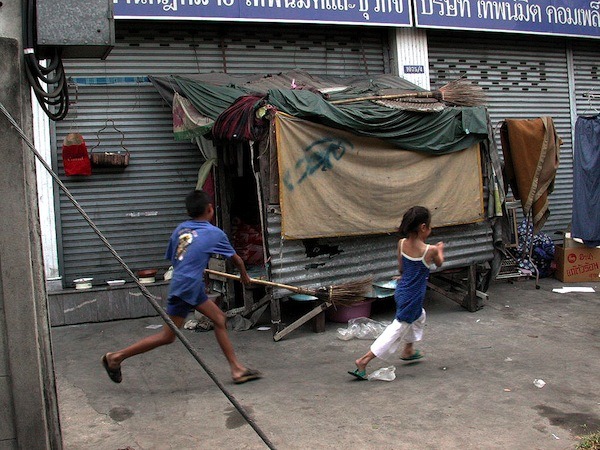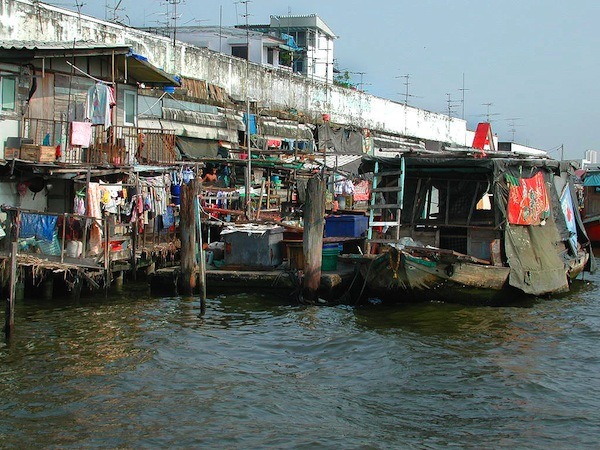The Duang Prateep Foundation Reaches Out in Bangkok’s Slums and Beyond
[A] duck barks, then croaks, then meows. Students of the Pattana Village School in Bangkok’s Klong Toey slum sit on the concrete floor of the schoolyard to watch the Nithan Caravan puppet show. Some of the children laugh at the absurdities they see on stage and make clown faces with their friends.
Others are more serious, held back by shyness or uncertainty. But sometimes, they can’t help it, and laughter breaks their scowls.
Prateep Ungsongtham-Hata, original creator of the school and now Secretary General and founder of the Duang Prateep (Flame of Hope) Foundation that coordinates Nithan Caravan, understands their wariness. She was a happy child, she says, but growing up in Klong Toey was and still is an uncertain life, despite recent improvements.
She remembers arriving home from elementary school one day just in time to watch her house tumble to the ground in a cloud of dust and feathers and squawking poultry. The cacophony deafened her for a moment, and she just stood there, confused.
“Our chickens and ducks — our livelihood! Our home was being demolished by Port Authority workers. Twenty or thirty of them,” says Ungsongtham-Hata. “When I watched that I felt…Oh! Why are these people doing that? We want to stay!”
Guidebooks describe Bangkok as “the Venice of Asia” because of its network of canals. But at the end of World War II, Klong Toey was just a thousand acres of swampy, useless land around the Port Authority of Thailand (PAT). People who left their rural homes in search of better opportunities in the city settled there as squatters.

“They were so poor, where else could they go?” says Dr. Vithavas Khongkhakul, a retired urban sociologist who is now Vice-Chairman of the Duang Prateep Foundation. “Most of them could not afford to pay rent. They were just looking for a place to set up their shacks.”

The migrants worked for low wages loading and unloading ships, so the Port Authority turned a blind eye to their illegal settlements. However, when new technology replaced human labour in the 1950s, the squatters lost a lot more than their jobs.
“With the coming of the shipping container system, more space was needed for unloading, so they had to evict people,” says Khongkhakul.
Those were difficult times for Ungsongtham-Hata and her family, who were uprooted five times in the course of her childhood.
“At that time,” she says, “we had no water, no electricity, no concrete walkways, just, literally, planks of wood to walk on. I had to carry water. And there was no school in the slum. Many of my friends could not go to school. But my mother, she had a really strong feeling about education.”
Ungsongtham-Hata’s mother grew up in a rural area south of Bangkok. Only boys were allowed to attend the schools at Buddhist temples, but she managed to steal some learning for herself.
“She learned to read and write because she would look at how the monks taught” says Ungsongtham-Hata. Her father had fled China when fighting broke out between the Communists and the Kuomintang, and settled in her mother’s village. Formerly a basket-weaver, he took up fishing in Thailand. When debts accumulated he fled once again, this time with a wife and five children. Ungsongtham-Hata, the youngest, was born in Klong Toey. She was just as determined as her mother about getting an education.
Even as a student in elementary school, Ungsongtham-Hata had to work as a vendor. As a teenager, she quit school altogether and took on two jobs, one at a firecracker factory and another at the ports, scraping rust from the boats. She went to high school at night and opened the One Baht School, where she and her sister taught Klong Toey children.
In 1970, she enrolled at Suan Dusit, one of Bangkok’s most prestigious teachers’ colleges. It took her longer than expected to graduate because she had to continue working.
“I didn’t have a scholarship,” she says proudly. “I was a self-funded student. I had no teenage life. Only work, work, work.”
Because of this tireless determination, she quickly became a community leader. She understood that to educate the children she needed to strengthen their community first.
In 1976, when the city fired off another round of eviction notices, one of them was posted on the doors of Klong Toey’s informal school. Ungsongtham-Hata negotiated a deal with city officials, and her Baht-A-Day school was moved to a permanent building. Under the stewardship of the city, it became the “Pattana Village School.”
Ungsongtham-Hata’s fame spread beyond Klong Toey. In 1978, she won the Asia-wide Magsaysay Award and used the money to found the Duang Prateep Foundation. In 1980, the John. D. Rockefeller Youth Award for Outstanding Contribution to Mankind provided the funds for the Foundation for Slum Child Care.
The DPF’s origins were humble. In 1978, five people worked in a small office. Now, its three-floor building houses 100 employees, 20 volunteers who work full-time and many more who pitch in when they can. Some are recruited internationally, but most are Klong Toey residents who communicate regularly with area committees. This allows Ungsongtham-Hata to keep abreast of the issues that need to be addressed.
Khongkhakul credits Ungsongtham-Hata for almost single-handedly bringing essential services to Klong Toey which, with 80, 000 residents, is Bangkok’s largest slum.
“There have been a lot of battles, people fighting for their rights: electricity, water, garbage pick-up, cement walkways instead of wooden planks. Prateep is the one who’s organized this. She’s the strength of the community.”
In March 2000 Ungsongtham-Hata ran for senator in Thailand’s first elected Senate. In a letter explaining this decision to DPF benefactors, she wrote:
“It will give me a new forum in which I can represent the people I have been trying to help since I was a teenager teaching slum kids.”
Ungsongtham-Hata was one of 18 community activists and one of 20 women elected to the two-hundred-member senate. Previously, the appointed senate had been a cog in the machinery of corrupt Thai politics, but the new elected Senators were given powers to vet bills and fire ministers and judges.
Though the government of Prime Minister Shinawtra Thaksin has implemented some anti-poverty measures, it is still so corrupt that his attempts to reach out to the poor are meaningless, according to Khongkhakul.
“You are a local politician, I am a community leader,” he explains. “You come to me and offer me money. Even though you are no help, if you give me enough money, I will support you.”
Furthermore, says Khongkakul, politicians get kickbacks from developers, so they are more than happy to grant contracting licenses that cause evictions.
Ungsongtham-Hata is not quite as pessimistic about Thaksin. She admits that his government, like the ones that preceded it, is corrupt, but this one at least tries to reach out to the poor. Thanks to her political status, she can plead with ministers to help with problems like evictions.
“A senator has more power to call on high-level people.”
Because of advocates like Ungsongtham-Hata, Klong Toey has seen a lot of improvements since 1976, but there is still a considerable gap between its residents and Bangkok’s expanding middle class. In the cab on my way to Klong Toey, I notice a branch of the hypermarket chain Tesco-Lotus, as well as a Bangkok University campus. Well-dressed students are hanging out, munching skewered grilled squid and sipping Thai-style iced tea. Our taxi driver pulls up and asks them if they know how to get to Klong Toey. They don’t. Klong Toey may not be far, but it is hidden behind a maze of highways and overpasses.
The driver has to call the Foundation for directions. After a series of U-turns, we are on the right road. Across the river, a few temporary-looking homes appear. On their clotheslines flap bright yellow commemorative T-shirts. Like the rest of the country, Klong Toey residents are celebrating the sixtieth anniversary of the King’s coronation.
Ungsongtham-Hata is having lunch in the cafeteria of the DPF building. While answering interview questions, she also practices Japanese with a volunteer from Osaka. She points to a dish on her tray, an herbal concoction the kitchen staff has prepared for her sore throat.
“It’s like medicine. Very bitter,” she says. “That’s why I didn’t give you any.”
Since giving is second nature to her, she feels compelled to explain this apparent lapse in her generosity.
In addition to running 11 kindergartens and special programs for disabled children, DPF uses money from sponsors to set up individual accounts for disadvantaged students all over Thailand. In total, they keep 2500 children in school.
Strengthening the community is still a priority. The proximity of slum dwellings makes fires a particularly vicious hazard, so DPF trains fire-fighter volunteers with used fire-engine trucks donated by Japan. A credit union set up for Klong Toey residents ensures that they do not fall prey to loan sharks when these emergencies cause financial setbacks.
The Foundation also runs programs for the elderly. Today’s lunch, for example, is a weekly event for Klong Toey’s elders and caters to their dietary needs.
In 1988, while most of the world still considered AIDS a disease confined to “high-risk” groups, DPF began to educate not just sex trade workers but the entire Klong Toey community. Today, DPF distributes condoms and flyers and trains families to provide home-care to AIDS patients. The New Life Project sends drug-addicted youth to the countryside, where they can start clean through education, technical training and farm work.
Nithan Caravan is a special project that tries to reach children before the drugs and peer pressure can bring them down.
In 1986, Tatsuya Hata, a Japanese citizen working for NGOs in Bangkok, introduced Ohanashi Caravan, a puppet troupe from Tokyo, to the DPF. He fell in love with Prateep Ungsongtham, and eventually they married, though initially she had other priorities in mind.
The puppets were a fun and effective pedagogical tool, and she sent one of her staff members, Ratjana Phraesrithong, to train in Tokyo. When Phraesrithong came back, she set up Nithan Caravan, Klong Toey’s very own, self-sufficient puppet troupe. In an office of the DPF, the performers make their own puppets and come up stories based on Thai and international storybooks. At the end of the performance, they encourage children to read and learn more about their favourite characters.
Today’s performance features a duck that learns to bark from a dog, meow from a cat, and croak from a frog. When his parents hear him speak in these strange tongues, they remind him to be proud of his own language.
“The show is aimed at teaching children about self-esteem,” says Ratanaporn Srisuttikul, one of the performers. Her hair is long and wavy, and her pink lipstick enhances her smile. She is full of energy when she stands in front of the children, microphone in hand, warming them up with the help of a popular kids’ song.
As a mother of 2 teenagers, Srisuttikul understands how peer-pressure, pop culture and the media can chip away at a child’s self-esteem.
“Children try to upgrade themselves,” she says. “They make themselves more fashionable so they’ll be accepted.” The children of Klong Toey are especially vulnerable to low self-esteem because of persistent stereotypes about slum residents.
“People view Klong Toey as a place full of drugs and murder,” says Srisuttikul, adding that she too has faced prejudice because of her association with the slum.

Educators across Bangkok always respond with enthusiasm when she phones to set up a performance at their schools. But when she reveals that Nithan Caravan is based in Klong Toey, shock is a common reaction.
“If we experience such prejudice,” she says, “then the children must experience it too. But once we perform the show at their schools, they ask us to come back.”
Srisuttikul’s performance is energetic, and afterwards, perspiration beading through her make-up, she admits it has worn her out a bit. But a hearty lunch is all it takes to reenergize her for the next performance, at a school in a distant suburb. The caravan, a white van, is parked right out front. The performers stuff drums, amplifiers, microphones, and bins full of puppets into it, and Srisuttikul and her fellow puppeteers cram themselves into the remaining space. John, a young musician who plays the drums and cymbals that add so much drama to the performances, climbs onto the roof and holds onto the luggage rack. The van takes off, carrying Duang Prateep’s message of high achievement to yet another young audience.
Besides performing at schools all over Bangkok, Nithan Caravan reaches out to Thailand’s rural children, whose disadvantages are not dissimilar to those faced by the students in Klong Toey.
On December 26, 2004, when the Indian Ocean tsunami hit Thailand’s Southern coast, the DPF could not simply ignore it. They sent a few staff members to one of the worst-affected areas, Phang Nga, with tents and emergency supplies. Khantong Dalad, DPF’s Head of Information Services, was one of the first on the scene. He remembers that they didn’t have to go looking for the children.
“They came,” he says simply.
Two small brothers and a distant uncle who started drinking when he lost his livelihood as a fisherman. A grandmother so stricken by grief and old age that she could not take care of her grand-daughter. The need was so great in Phang Nga that the DPF built an orphanage.
One-and-a-half years later, Phang Nga has the look of a permanent community again. International foundations such as Save the Children and the Red Cross have built bungalows for families. Still, Dalad has a feeling that no one in Phang Nga will ever feel settled again.
“The children do not want to look at the sea. Today it’s sunny, but they can’t trust it. Because on December 26, it was also like this, such a beautiful day,” says Dalad. “And then the tsunami came.”
Ratjana Phraesrithong, who was Nithan Caravan’s troupe leader until she came to Phang Nga a year ago to set up the orphanage, witnesses the same insecurity.
“The children have a lot of psychological problems. When it rains, they are scared. They think the tsunami will come again. They want someone to hold them,” she says.
Phraesithong wishes she could spend more time with the children, but she is too busy negotiating with contractors and making sure that the orphanage has enough sponsors. Anyways, she says, her local employees are better equipped to comfort the children.
“One of the workers lost all her family” says Phraesrithong. “It’s good for people who have suffered the same thing to work together.”
Like Ungsongtham-Hata, Phraesrithong is from Klong Toey and knows about growing up with all the odds against you. Still, she insists that her situation cannot be compared to theirs. Though poverty was difficult, it was not an impediment to her family’s happiness. It was an asset. Since they had no television, her father would tell folktales to entertain his children. Phraesrithong remembers one story about a chicken, who dies in a fire along with his entire family. Eventually, they are all resurrected as stars in the sky.
Phraesrithong inherited from her father a love of storytelling, singing and the arts, so Ungsongtham-Hata gave her the opportunity to train with Ohanashi Caravan in Tokyo.
“When children laugh, they forget” says Phraesrithong, adding that once everything is settled in Phang Nga, Nithan Caravan will train local educators to work with puppets.
These new projects in the South have created more work for the Duang Prateep Foundation. Ungsongtham-Hata doesn’t mind, though. Her sore throat has healed and she is in top shape on August 28th, when she arrives in Phang Nga for the next day’s ground-breaking ceremony for the orphanage, coinciding with the DPF’s twenty-eighth anniversary. By the time she’s sure that everything has been arranged — welcome carpets, flowers, microphones, monks for the blessing ceremony, gifts for the sponsors — it is night, and she sits down for dinner with a few of the sponsors from Europe, North America and Japan. Her smile never wanes, though she is exhausted.
The next morning, Ungsongtham-Hata and a few DPF employees rush through an early breakfast in the elegant dining room of a beach resort. She is dressed in a traditional formal sarong and a bright yellow T-shirt, in honour of the King. The landscape cascades down to a grove of palm trees that opens up to a peek of idyllic blue sky and turquoise ocean, worlds away from the poverty and grind of Klong Toey, and from the death and terror of the tsunami. A prickling of guilt precipitates a justification:
“The owner knows about the work of the foundation,” she says. “So he gives us a big discount.”
If Ungsongtham-Hata indulges in a bit of luxury for herself, she also shares unsparingly. The entire community has been invited to the celebration. A lunch of fish cakes, pork, curries, rice and noodles is followed by fruit and dessert. Government officials and local aid workers make speeches. The monks bless the orphanage, and the children take the stage with traditional and modern dances.
The local guests sit in groups of seven, eight, nine. It’s hard to tell whether they are related by blood or have formed new ties since losing their families. Most of them seem pleased, but they eat in silence. It’s been a year and a half since the tsunami. Not very long at all. The survivors still seem a little shell-shocked, guarded. Like the kids in Klong Toey, they hesitate to smile. Uncertainty lingers, even in the midst of celebration.
Duang Prateep Foundation www.dpf.or.th/en/



